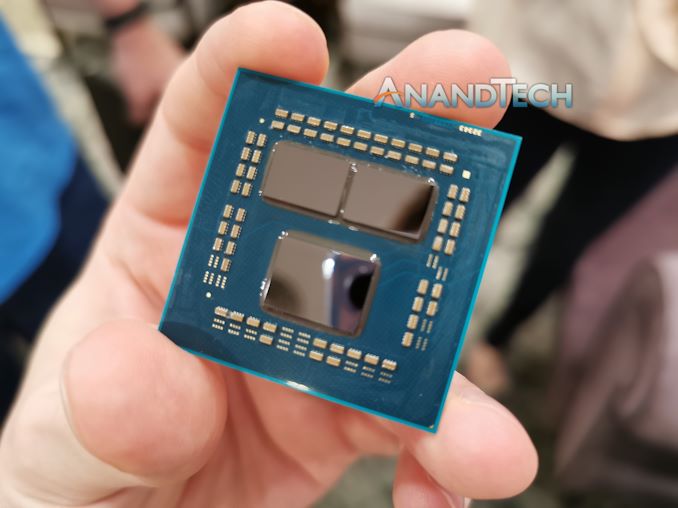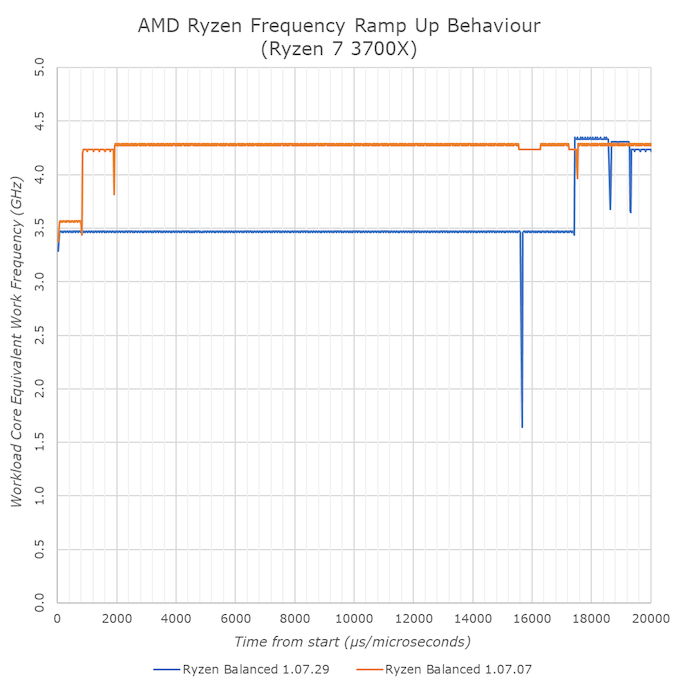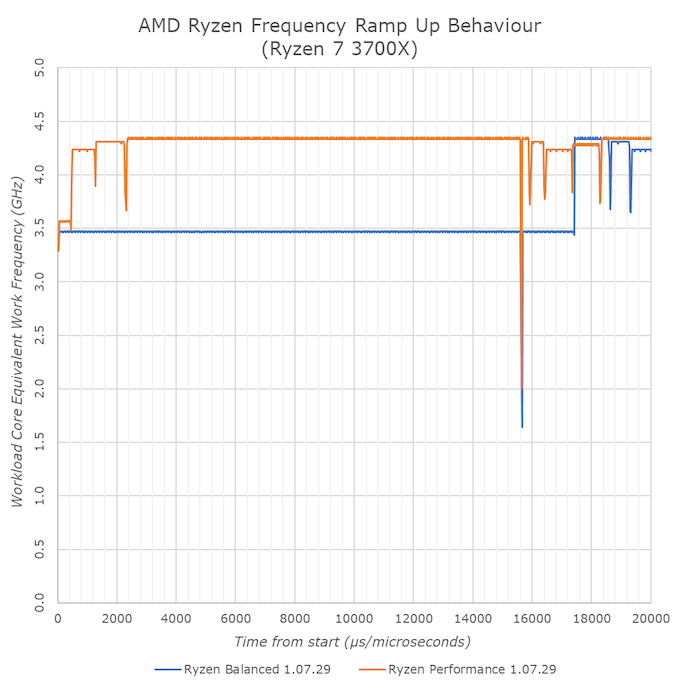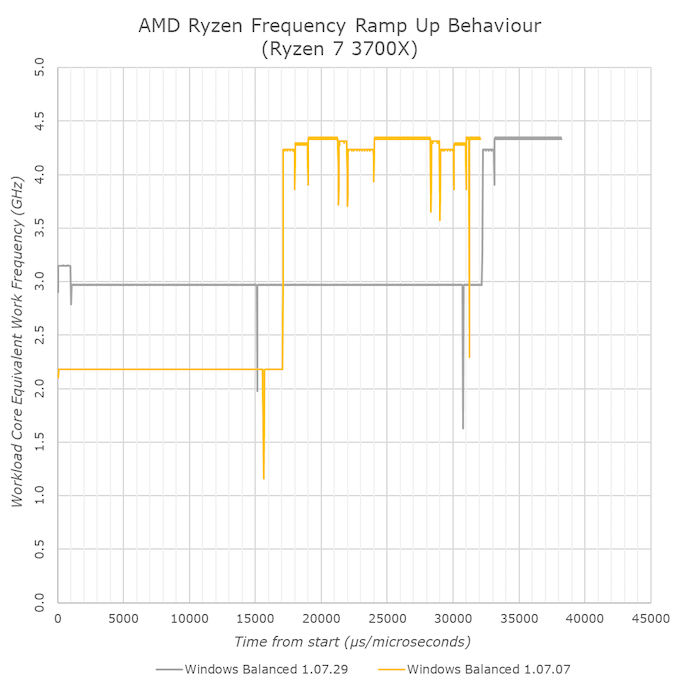AMD Releases New Chipset Drivers For Ryzen 3000: More Relaxed CPPC2 Upscaling
by Andrei Frumusanu on July 30, 2019 5:00 PM EST
It’s been nearly three weeks since AMD’s launch of the new Ryzen 3000 series CPUs and our extensive coverage of the new parts. Among one of the things that didn’t quite go as smoothly is AMD’s BIOS and software situation where as things were still very much in flux following the launch.
One issue that was repeatedly brought up by the community over the past weeks was the new CPU’s idle behaviour both in terms of temperature as well as voltages. In particular, the new parts seemingly looked like they rarely idled at lower performance states and instead looked to remain at high frequencies even when not doing much.
While initially appearing as an issue, it really wasn’t one and rather just a side-effect of AMD’s new CPPC2 fast frequency ramp-up behaviour. Monitoring applications that are badly programmed tend to have a too heavy of a monitoring loop that causes load on the CPU – triggering a frequency ramp-up as the CPU is seeing a larger load. Given the new CPU’s sub-1ms ramp-up this meant that it was very hard to actually catch the machine at the lower frequencies – even though it most likely did idle correctly.
AMD has now addressed this concern and tweaked the CPPC2 behaviour in the new Ryzen power plans with the release of a new chipset driver package.
As AMD states in their community brief on the issue, part of the new behaviour change is that the new scheduler settings will now have a much more relaxed ramp-up time compared to the previous versions. In particular, when the chip will be at its base frequency and idling voltage, it will now take a significantly longer load for the chip to ramp up to its boost frequencies.
In our quick A/B testing between the two driver versions, we can see that prior to the update the CPU would ramp up in around 840 microseconds to its boost clocks, whilst on the new power plan in this data-set took it a longer 17.5 milliseconds.
The new behaviour thus should make the CPU ramp-up much less susceptible to smaller transient loads. The new boost duration is still very much adequate and extremely fast – sustained CPU workloads will see largely imperceptible difference, while intermittent workloads such as games also won’t be affected as once the CPU gets over the initial base frequency ramp threshold it maintains the sub-1ms frequency change behaviour.
Users who with to maintain the fast up-scaling behaviour can choose to use the Performance power plan which largely retains a similar performance profile to that of the previous Balanced profile.
I also took a look at the Windows power plans if they changed, and it seemed that they indeed did. While on the old version the CPU would idle at ~2.2GHz, the new driver idles at 3GHz. Seemingly the frequency up-scaling has also been slightly slowed down as in my quick testing I saw frequency ramp up half as quickly.
AMD has also addressed concerns about the reported high temperatures of the chip. The company explains that generally the value that most applications are reading out is the maximum of several sensors on the chip. Essentially this acts as the junction temperature of the chip – whilst most of the die would actually be a different/lower temperature.
A new version of Ryzen Master now includes a different temperature readout algorithm that is meant to better represent the “overall” temperature of the die rather than the absolute maximum a sensor reports. AMD says this is a better representation of the temperature of the CPU. Besides averaging across different sensors, it also averages readouts over a small time-window. In my testing the most affected scenarios are idle and low-load scenarios and the new temperature behaviour isn’t nearly as erratic and spiky.
Note: People have reported performance degradations with the new driver. These degradations have nothing to do with the new power plan / idle behaviour; it's more likely that this is caused by the temporary workaround for the RDRAND (Destiny 2) issues. One can maintain the original performance with the new Balanced power plan idle behaviour by simply selectively installing the new 5.0.0.0 power plan on top of the 07.07 chipset driver release.
Related Reading:
Source: AMD Community Update














39 Comments
View All Comments
Daver73 - Tuesday, July 30, 2019 - link
It doesn't idle at 30W--even without the update. As stated in the article, it ramps up with some over-aggressive monitoring software. By taking measurements at a very fast rate, the CPU interprets that as a heavy workload and ramps up accordingly.drexnx - Tuesday, July 30, 2019 - link
I can tell you that mine did/does, unless I switched windows power plan to "power saver" - I tried the 85/100 trick, it didn't work.Ryzen master said 41% of 88W PPT at idle
whatever, it's not a huge deal as long as they fix it (and I'm sure they will)
yetanotherhuman - Wednesday, July 31, 2019 - link
Don't use power saver, it artificially throttles the CPU back.I don't know if it's relevant today, but back in the Windows 2000 days, Power Saver didn't even save power, it instead ran a simple process to waste time and slow the effective responsiveness of the machine, but I could be misremembering it horribly.
drexnx - Wednesday, July 31, 2019 - link
I only do it when I'm done with it for the night and know it'll be idle until the next nightQasar - Thursday, August 1, 2019 - link
i just turn my comp off when i am done for the night :-) saves even more powerDragonstongue - Tuesday, July 30, 2019 - link
yeh, RAM wise they have seemingly sorted out all the ills (that I can tell)I think for Ryzen (Zen, Zen+, Zen2 as well as the APU based on such) there are just far far more "turn this on, turn that off" hundreds of times per second over "lots of space", I would imagine a little "burp" at this level is not a "burp" it becomes a grindy/grinding mess in real quick order (not good)
I know Zen1 and Zen2 share more than Zen2 and Zen+ do (from what I have read) so that likely means Zen 3 or was Zen 4 (final for AM4 according to AMD) will combine all the bits and piece to make the "true" enchilada Ryzen Ultra (something like that)
scheduler from Zen 1 and 2 are similar Zen+ is "it's own" but the turbo and CCX design more like Zen+ than Zen 1, a few new things added to the mix, so, they basically had to "reset" 3 times their base design.
they seem to be "figuring out" quicker but sadly is not like "the good ole days" where say AMD 700 through 900 were "near identical" from the motherboard side of things (YMMV if it acted simple as should have) certainly not a shelf full of buy when you want motherboards 3 generations back to back (sucks balls) but hey, if x570 are being held back by the ones who "might care" to ensure less problems, that might make sense why pretty much impossible to get an x570 motherboard currently (without taking the multi hundred $$$ will it work "trial"
ask Nvidia how "easy" it is to make Motherboards (or should say) easy to screw up than make work "proper"(they still suck arse at drivers for the so called "leader in graphics" leader means "best" not "sometimes better" silly Huang ..
notice Nv has not been in motherboard land for many years, shame they not put their attention to "quality" over parading on stage with leather coat and all (all those who bought RTX 2xxx or 1650/60 you got "super slapped" only cost you a few hundred $$$$ gave Nv a wicked belly laugh as well.
LordConrad - Wednesday, July 31, 2019 - link
I just built a computer with a Ryzen 5 3600 and a MSI B450 Tomahawk motherboard. After upgrading the BIOS everything boots and performs flawlessly. I think this processor, boost and all, works just fine the way it is and I see no reason to change it.ZolaIII - Wednesday, July 31, 2019 - link
A blink of an eye (20 miliseconds) is right way to go or a tad less, at least while operator is human. I always had three stage approach; set active idle frequency to one that which OS white noise (common usually appearing background tasks) can compiutionaly sustain on given CPU without crossing utilisation limit to ramp up, set it to rump up almost instantly to ideal leak/performance delta frequency (around 1.2 GHz on FinFET) & make sure it doesn't ramp up without a real need (hi utilised workload) behind some sain set limit (2~2.2 GHz).USGroup1 - Wednesday, July 31, 2019 - link
"sustained CPU workloads will see largely imperceptible difference, while intermittent workloads such as games also won’t be affected as once the CPU gets over the initial base frequency ramp threshold it maintains the sub-1ms frequency change behaviour."You know what will be affected? some benchmarks, and this is exactly why they didn't do it at launch.
Daver73 - Wednesday, July 31, 2019 - link
You would hope anyone running benchmarks would know to set the power plan to Performance, but, yeah, I guess it wouldn't surprise me to learn that some testers don't.